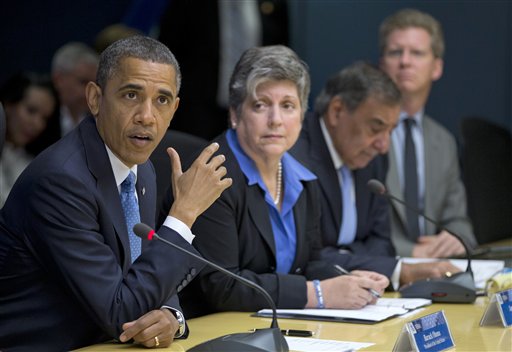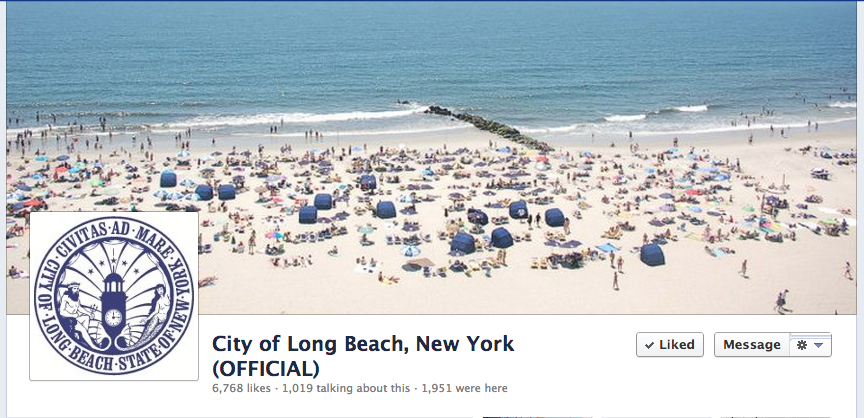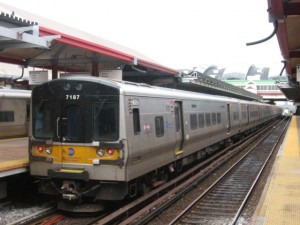

FILE – In this Oct. 31, 2012 file photo, President Barack Obama, accompanied by members of his Cabinet, speaks at the Federal Emergency Management Agency (FEMA) Headquarters in Washington to discuss Superstorm Sandy. From second left are Homeland Security Secretary Janet Napolitano, Defense Secretary Leon Panetta, and Housing and Urban Development (HUD) Secretary Shaun Donovan. Obama on Friday, Dec. 7, 2012 asked Congress for $60.4 billion in federal aid for New York, New Jersey and other states hit by Superstorm Sandy in late October. It’s a disaster whose cost is rivaled only by the Sept. 11, 2001 terrorist attacks and the 2005 Hurricane that devastated New Orleans and the Gulf Coast. (AP Photo/Carolyn Kaster, File)
President Barack Obama’s proposal for $60.4 billion in federal aid for states hit by Superstorm Sandy adds a huge new item to an end-of-year congressional agenda already packed with controversy.
The president’s request to Congress on Friday followed weeks of discussions with lawmakers and officials from New York, New Jersey and other affected states who requested significantly more money, but generally praised the president’s request as they urged Congress to adopt it without delay.
“It’s not everything we wanted, but it’s close enough,” said Sen. Charles Schumer, D-N.Y.
Pushing the request through Congress in the few weeks left before lawmakers adjourn at the end of the year will be no easy task. Washington’s attention is focused on the looming fiscal cliff of expiring Bush-era tax cuts and automatic spending cuts to the Pentagon and domestic programs set to begin at the end of the year. And tea party House Republicans are likely to press for budget cuts elsewhere to offset some or even all disaster costs.
Those complications raised the prospects that the measure will be delayed in whole or in part until next year, although Schumer said the goal is to get it done by Dec. 31.
The measure is likely to advance first in the Democratic-controlled Senate, where supporters hope it can be quickly analyzed and brought the floor as early as next week. House Speaker John Boehner, R-Ohio, has also received the request and is reviewing it, a spokesman said.
The massive request blends aid for homeowners, businesses, and state and local governments walloped by Sandy, a disaster whose cost is rivaled only by the 9/11 terrorist attacks and Hurricane Katrina, which devastated New Orleans and the Gulf Coast in 2005.
The aid will help states rebuild public infrastructure like roads and tunnels and help thousands of people displaced from their homes. Most of the money — $47.4 billion — is for immediate help for victims and other recovery and rebuilding efforts. Another $13 billion would be used for mitigation efforts to protect against future storms.
“We are committed to ensuring federal resources are used responsibly and that the recovery effort is a shared undertaking,” Jeffrey D. Zients, deputy director of Obama’s budget office, wrote to congressional leaders.
Obama’s request was met with praise from two governors who had traveled to Washington last week to press for as much help as possible: New York’s Andrew Cuomo and New Jersey’s Chris Christie. New York, New Jersey and Connecticut together are seeking about $83 billion in aid.
“We thank President Obama for his steadfast commitment of support and look forward to continuing our partnership in the recovery effort,” Cuomo and Christie said in a joint statement.
Friday’s request was at the top end of what had been expected and came after Obama allies like Schumer had criticized the White House following reports it had settled on a $50 billion figure. As is traditional in natural disasters, the request was not accompanied by offsetting spending cuts to defray its cost.
The measure contains $11.5 billion for the Federal Emergency Management Agency’s chief disaster relief fund and $17 billion for community development block grants, much of which would help homeowners repair or replace their homes. Another $11.7 billion would help repair New York City’s subways and other mass transit damage and protect them from future storms. Some $9.7 billion would go toward the government’s flood insurance program. The Army Corps of Engineers would receive $5.3 billion to mitigate flood future risks and rebuild damaged projects. Dozens of other smaller items are also included in the 73-page official justification.
Praise for the proposal was not universal.
“We should not shortchange nor add strings to the support residents, businesses and communities in my district and across the region desperately need,” said Republican Rep. Frank LoBiondo, whose southern New Jersey district includes hard-hit Atlantic City. “I will continue to work with my colleagues to ensure the federal aid package passed by Congress realistically matches the needs identified by the states on the ground.”
The late October storm flooded parts of the East Coast when it roared ashore, creating a storm surge that left parts of New York City underwater and millions of people in several states without heat or electricity for weeks.
Superstorm Sandy is blamed for at least 125 deaths, including 60 in New York, 34 in New Jersey and 16 in Pennsylvania. At least seven people died in West Virginia, where the storm dropped heavy snow. Sandy damaged or destroyed more than 72,000 homes and businesses in New Jersey. In New York, 305,000 housing units were damaged or destroyed and more than 265,000 businesses affected.
On Tuesday, the head of the Federal Emergency Management Agency, Craig Fugate, said the government’s disaster relief fund still has $4.8 billion, enough to pay for recovery efforts into early spring. So far, the government has spent about $2 billion in the 11 states struck by the storm.
Copyright 2012 The Associated Press.






